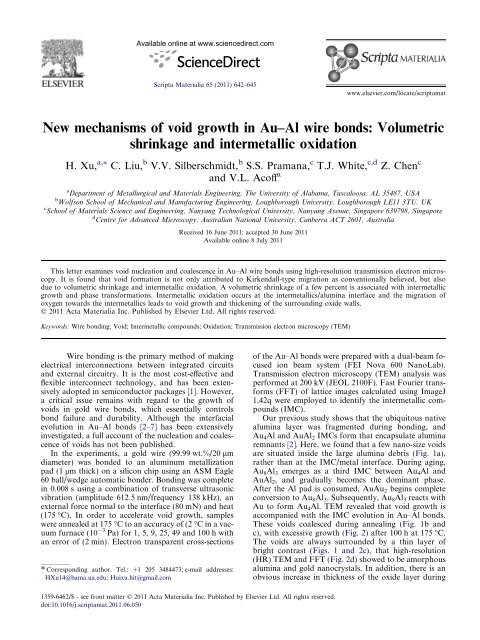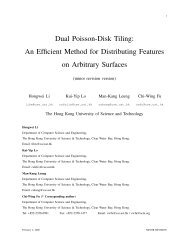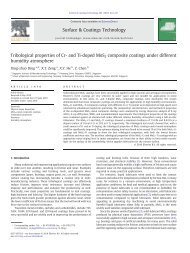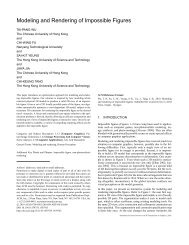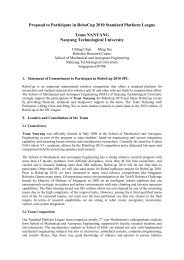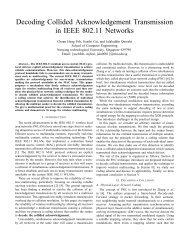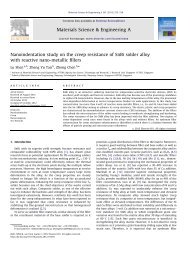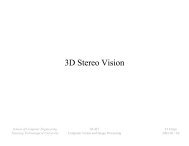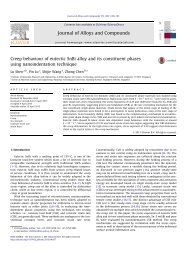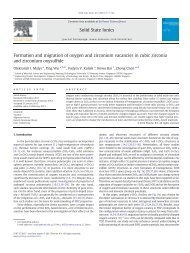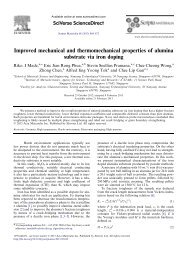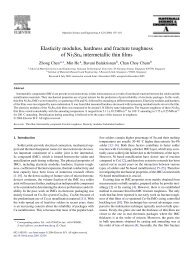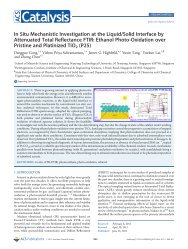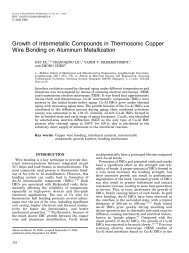New mechanisms of void growth in Au-Al wire bonds - Nanyang ...
New mechanisms of void growth in Au-Al wire bonds - Nanyang ...
New mechanisms of void growth in Au-Al wire bonds - Nanyang ...
Create successful ePaper yourself
Turn your PDF publications into a flip-book with our unique Google optimized e-Paper software.
Available onl<strong>in</strong>e at www.sciencedirect.com<br />
Scripta Materialia 65 (2011) 642–645<br />
<strong>New</strong> <strong>mechanisms</strong> <strong>of</strong> <strong>void</strong> <strong>growth</strong> <strong>in</strong> <strong>Au</strong>–<strong>Al</strong> <strong>wire</strong> <strong>bonds</strong>: Volumetric<br />
shr<strong>in</strong>kage and <strong>in</strong>termetallic oxidation<br />
H. Xu, a,⇑ C. Liu, b V.V. Silberschmidt, b S.S. Pramana, c T.J. White, c,d Z. Chen c<br />
and V.L. Ac<strong>of</strong>f a<br />
a Department <strong>of</strong> Metallurgical and Materials Eng<strong>in</strong>eer<strong>in</strong>g, The University <strong>of</strong> <strong>Al</strong>abama, Tuscaloosa, AL 35487, USA<br />
b Wolfson School <strong>of</strong> Mechanical and Manufactur<strong>in</strong>g Eng<strong>in</strong>eer<strong>in</strong>g, Loughborough University, Loughborough LE11 3TU, UK<br />
c School <strong>of</strong> Materials Science and Eng<strong>in</strong>eer<strong>in</strong>g, <strong>Nanyang</strong> Technological University, <strong>Nanyang</strong> Avenue, S<strong>in</strong>gapore 639798, S<strong>in</strong>gapore<br />
d Centre for Advanced Microscopy, <strong>Au</strong>stralian National University, Canberra ACT 2601, <strong>Au</strong>stralia<br />
Received 16 June 2011; accepted 30 June 2011<br />
Available onl<strong>in</strong>e 8 July 2011<br />
This letter exam<strong>in</strong>es <strong>void</strong> nucleation and coalescence <strong>in</strong> <strong>Au</strong>–<strong>Al</strong> <strong>wire</strong> <strong>bonds</strong> us<strong>in</strong>g high-resolution transmission electron microscopy.<br />
It is found that <strong>void</strong> formation is not only attributed to Kirkendall-type migration as conventionally believed, but also<br />
due to volumetric shr<strong>in</strong>kage and <strong>in</strong>termetallic oxidation. A volumetric shr<strong>in</strong>kage <strong>of</strong> a few percent is associated with <strong>in</strong>termetallic<br />
<strong>growth</strong> and phase transformations. Intermetallic oxidation occurs at the <strong>in</strong>termetallics/alum<strong>in</strong>a <strong>in</strong>terface and the migration <strong>of</strong><br />
oxygen towards the <strong>in</strong>termetallics leads to <strong>void</strong> <strong>growth</strong> and thicken<strong>in</strong>g <strong>of</strong> the surround<strong>in</strong>g oxide walls.<br />
Ó 2011 Acta Materialia Inc. Published by Elsevier Ltd. <strong>Al</strong>l rights reserved.<br />
Keywords: Wire bond<strong>in</strong>g; Void; Intermetallic compounds; Oxidation; Transmission electron microscopy (TEM)<br />
Wire bond<strong>in</strong>g is the primary method <strong>of</strong> mak<strong>in</strong>g<br />
electrical <strong>in</strong>terconnections between <strong>in</strong>tegrated circuits<br />
and external circuitry. It is the most cost-effective and<br />
flexible <strong>in</strong>terconnect technology, and has been extensively<br />
adopted <strong>in</strong> semiconductor packages [1]. However,<br />
a critical issue rema<strong>in</strong>s with regard to the <strong>growth</strong> <strong>of</strong><br />
<strong>void</strong>s <strong>in</strong> gold <strong>wire</strong> <strong>bonds</strong>, which essentially controls<br />
bond failure and durability. <strong>Al</strong>though the <strong>in</strong>terfacial<br />
evolution <strong>in</strong> <strong>Au</strong>–<strong>Al</strong> <strong>bonds</strong> [2–7] has been extensively<br />
<strong>in</strong>vestigated, a full account <strong>of</strong> the nucleation and coalescence<br />
<strong>of</strong> <strong>void</strong>s has not been published.<br />
In the experiments, a gold <strong>wire</strong> (99.99 wt.%/20 lm<br />
diameter) was bonded to an alum<strong>in</strong>um metallization<br />
pad (1 lm thick) on a silicon chip us<strong>in</strong>g an ASM Eagle<br />
60 ball/wedge automatic bonder. Bond<strong>in</strong>g was complete<br />
<strong>in</strong> 0.008 s us<strong>in</strong>g a comb<strong>in</strong>ation <strong>of</strong> transverse ultrasonic<br />
vibration (amplitude 612.5 nm/frequency 138 kHz), an<br />
external force normal to the <strong>in</strong>terface (80 mN) and heat<br />
(175 °C). In order to accelerate <strong>void</strong> <strong>growth</strong>, samples<br />
were annealed at 175 °C to an accuracy <strong>of</strong> (2 °C <strong>in</strong> a vacuum<br />
furnace (10 3 Pa) for 1, 5, 9, 25, 49 and 100 h with<br />
an error <strong>of</strong> (2 m<strong>in</strong>). Electron transparent cross-sections<br />
⇑ Correspond<strong>in</strong>g author. Tel.: +1 205 3484473; e-mail addresses:<br />
HXu14@bama.ua.edu; Huixu.hit@gmail.com<br />
1359-6462/$ - see front matter Ó 2011 Acta Materialia Inc. Published by Elsevier Ltd. <strong>Al</strong>l rights reserved.<br />
doi:10.1016/j.scriptamat.2011.06.050<br />
www.elsevier.com/locate/scriptamat<br />
<strong>of</strong> the <strong>Au</strong>–<strong>Al</strong> <strong>bonds</strong> were prepared with a dual-beam focused<br />
ion beam system (FEI Nova 600 NanoLab).<br />
Transmission electron microscopy (TEM) analysis was<br />
performed at 200 kV (JEOL 2100F). Fast Fourier transforms<br />
(FFT) <strong>of</strong> lattice images calculated us<strong>in</strong>g ImageJ<br />
1.42q were employed to identify the <strong>in</strong>termetallic compounds<br />
(IMC).<br />
Our previous study shows that the ubiquitous native<br />
alum<strong>in</strong>a layer was fragmented dur<strong>in</strong>g bond<strong>in</strong>g, and<br />
<strong>Au</strong> 4<strong>Al</strong> and <strong>Au</strong><strong>Al</strong> 2 IMCs form that encapsulate alum<strong>in</strong>a<br />
remnants [2]. Here, we found that a few nano-size <strong>void</strong>s<br />
are situated <strong>in</strong>side the large alum<strong>in</strong>a debris (Fig. 1a),<br />
rather than at the IMC/metal <strong>in</strong>terface. Dur<strong>in</strong>g ag<strong>in</strong>g,<br />
<strong>Au</strong>8<strong>Al</strong>3 emerges as a third IMC between <strong>Au</strong>4<strong>Al</strong> and<br />
<strong>Au</strong><strong>Al</strong>2, and gradually becomes the dom<strong>in</strong>ant phase.<br />
After the <strong>Al</strong> pad is consumed, <strong>Au</strong><strong>Au</strong>2 beg<strong>in</strong>s complete<br />
conversion to <strong>Au</strong>8<strong>Al</strong>3. Subsequently, <strong>Au</strong>8<strong>Al</strong>3 reacts with<br />
<strong>Au</strong> to form <strong>Au</strong>4<strong>Al</strong>. TEM revealed that <strong>void</strong> <strong>growth</strong> is<br />
accompanied with the IMC evolution <strong>in</strong> <strong>Au</strong>–<strong>Al</strong> <strong>bonds</strong>.<br />
These <strong>void</strong>s coalesced dur<strong>in</strong>g anneal<strong>in</strong>g (Fig. 1b and<br />
c), with excessive <strong>growth</strong> (Fig. 2) after 100 h at 175 °C.<br />
The <strong>void</strong>s are always surrounded by a th<strong>in</strong> layer <strong>of</strong><br />
bright contrast (Figs. 1 and 2c), that high-resolution<br />
(HR) TEM and FFT (Fig. 2d) showed to be amorphous<br />
alum<strong>in</strong>a and gold nanocrystals. In addition, there is an<br />
obvious <strong>in</strong>crease <strong>in</strong> thickness <strong>of</strong> the oxide layer dur<strong>in</strong>g
Figure 1. Evolution <strong>of</strong> <strong>void</strong>s and the neighbor<strong>in</strong>g oxide layer <strong>in</strong> <strong>Au</strong>–<strong>Al</strong><br />
bond dur<strong>in</strong>g anneal<strong>in</strong>g process. (a) A few <strong>void</strong>s formed <strong>in</strong> the center <strong>of</strong><br />
large remnant alum<strong>in</strong>a particles prior to anneal<strong>in</strong>g; (b) a <strong>void</strong> tens <strong>of</strong><br />
nanometers <strong>in</strong> diameter after anneal<strong>in</strong>g for 5 h at 175 °C and (c) large<br />
<strong>void</strong>s <strong>of</strong> 100 nm or more <strong>in</strong> diameter after anneal<strong>in</strong>g for 25 h at 175 °C.<br />
H. Xu et al. / Scripta Materialia 65 (2011) 642–645 643<br />
Figure 2. <strong>Au</strong>–<strong>Al</strong> <strong>bonds</strong> after anneal<strong>in</strong>g for 100 h at 175 °C: (a) scann<strong>in</strong>g<br />
electron micrograph show<strong>in</strong>g large <strong>void</strong>s <strong>in</strong>side IMCs; (b) TEM image<br />
show<strong>in</strong>g <strong>void</strong>s a few micrometers <strong>in</strong> diameter; (c) HRTEM <strong>of</strong> region A<br />
<strong>in</strong> (b) show<strong>in</strong>g a th<strong>in</strong> layer that surrounded the <strong>void</strong>; (d) lattice image <strong>of</strong><br />
region A-1 <strong>in</strong> (c) <strong>in</strong>dicat<strong>in</strong>g that the th<strong>in</strong> layer consisted <strong>of</strong> amorphous<br />
alum<strong>in</strong>a and crystall<strong>in</strong>e gold nanoparticles.
644 H. Xu et al. / Scripta Materialia 65 (2011) 642–645<br />
Table 1. Calculated molar volumes <strong>of</strong> <strong>Au</strong>–<strong>Al</strong> IMCs.<br />
Phase Compound symmetry Space group Unit cell volume (A˚ 3<br />
) Number <strong>of</strong> formula weights per unit cell<br />
3 –1<br />
Molar volume (cm mol )<br />
<strong>Au</strong> fcc Fm-3m 67.85 4 10.21<br />
<strong>Al</strong> fcc Fm-3m 66.41 4 10.00<br />
<strong>Au</strong> 4<strong>Al</strong> Cubic (b 0 ) P2 13 331.76 4 49.95<br />
<strong>Au</strong> 8<strong>Al</strong> 3 Rhombohedral R-3c 724.77 4 109.11<br />
<strong>Au</strong>2<strong>Al</strong> Orthorhombic Pnma 190.54 4 28.68<br />
Orthorhombic Pnnm 475.16 10 28.61<br />
<strong>Au</strong><strong>Al</strong> Cubic Pm-3m 30.96 1 18.64<br />
Monocl<strong>in</strong>ic P21/m 135.26 4 20.36<br />
<strong>Au</strong><strong>Al</strong>2 Cubic Fm-3m 215.71 4 32.48<br />
Table 2. Volume change associated with IMC formation and phase<br />
transformation <strong>in</strong> <strong>Au</strong>–<strong>Al</strong> <strong>bonds</strong>.<br />
Reaction Volume change (%)<br />
<strong>Au</strong> + 2<strong>Al</strong> ! <strong>Au</strong><strong>Al</strong>2 +7.5<br />
<strong>Au</strong> + <strong>Al</strong> ! <strong>Au</strong><strong>Al</strong> 7.8<br />
2<strong>Au</strong> + <strong>Al</strong> ! <strong>Au</strong>2<strong>Al</strong> 5.7<br />
8<strong>Au</strong> + 3<strong>Al</strong> ! <strong>Au</strong>8<strong>Al</strong>3<br />
2.3<br />
4<strong>Au</strong> + <strong>Al</strong> ! <strong>Au</strong>4<strong>Al</strong> 1.8<br />
3<strong>Au</strong><strong>Al</strong>2 + 13<strong>Au</strong> ! 2<strong>Au</strong>8<strong>Al</strong>3 5.2<br />
<strong>Au</strong>8<strong>Al</strong>3 + 4<strong>Au</strong> ! 3<strong>Au</strong>4<strong>Al</strong> 0.1<br />
anneal<strong>in</strong>g, from 5 to 10 nm (5 h) to 10–20 nm (25 h) and<br />
to 50 nm (100 h) (Figs. 1 and 2).<br />
Void <strong>growth</strong> dur<strong>in</strong>g anneal<strong>in</strong>g is usually attributed to<br />
Kirkendall porosity [8], i.e. the faster diffus<strong>in</strong>g species<br />
create vacancies at a rate unmatched by vacancy fill<strong>in</strong>g.<br />
However, this study shows that <strong>void</strong>s are <strong>in</strong>side IMCs,<br />
but not at the metal and IMC <strong>in</strong>terface. The supersaturation<br />
<strong>of</strong> vacancies, seen <strong>in</strong> miscible b<strong>in</strong>ary alloy systems<br />
where there is ready diffusion <strong>of</strong> either species, may not<br />
be possible <strong>in</strong> <strong>in</strong>termetallic systems, and therefore some<br />
mechanism rather than the Kirkendall one may be applicable<br />
to the <strong>growth</strong> <strong>of</strong> <strong>void</strong>s <strong>in</strong> <strong>Au</strong>–<strong>Al</strong> <strong>bonds</strong> dur<strong>in</strong>g<br />
anneal<strong>in</strong>g.<br />
Stephenson [9] proposed that large plastic stresses<br />
developed between product phases aris<strong>in</strong>g from significantly<br />
different specific volumes may <strong>in</strong>itiate <strong>void</strong> formation<br />
between IMC layers. The molar volumes <strong>of</strong> IMCs<br />
can be calculated us<strong>in</strong>g:<br />
V m ¼ V cN a=Z ð1Þ<br />
where Vm is the molar volume <strong>of</strong> phase, V c is the volume<br />
<strong>of</strong> the unit cell, Na is the Avogadro constant (6.022<br />
10 23 mol 1 ) and Z is the number <strong>of</strong> formula weights<br />
per unit cell (Table 1). Volume changes associated with<br />
<strong>in</strong>termetallic <strong>growth</strong> and phase transformation <strong>in</strong> <strong>Au</strong>–<strong>Al</strong><br />
<strong>bonds</strong> are estimated us<strong>in</strong>g calculated molar volumes<br />
(Table 2). Except for <strong>Au</strong><strong>Al</strong>2, the <strong>growth</strong> <strong>of</strong> other IMCs<br />
results <strong>in</strong> shr<strong>in</strong>kage. S<strong>in</strong>ce <strong>Au</strong><strong>Al</strong>2 is a th<strong>in</strong> transitional<br />
phase compared to other IMCs, its contribution to the<br />
whole volume change can be ignored. The entire volumetric<br />
shr<strong>in</strong>kage <strong>in</strong>creases as <strong>Au</strong>8<strong>Al</strong>3 and <strong>Au</strong>4<strong>Al</strong> grow<br />
dur<strong>in</strong>g anneal<strong>in</strong>g, with stresses relieved by the <strong>in</strong>itiation<br />
and propagation <strong>of</strong> <strong>void</strong>s at weak regions. However, the<br />
analysis <strong>of</strong> molar volumes shows that shr<strong>in</strong>kage is only a<br />
few percent, which <strong>in</strong> itself is <strong>in</strong>sufficient to generate<br />
large <strong>void</strong>s (Fig. 2). Therefore, other factors must contribute<br />
to <strong>void</strong> <strong>growth</strong>.<br />
The evolution <strong>of</strong> the <strong>void</strong> and the surround<strong>in</strong>g oxide<br />
layer with anneal<strong>in</strong>g time is schematically illustrated <strong>in</strong><br />
Figure 3. Prior to anneal<strong>in</strong>g, the <strong>in</strong>itial <strong>void</strong>s are surrounded<br />
by a th<strong>in</strong> alum<strong>in</strong>a layer (5–10 nm thick) as seen<br />
<strong>in</strong> Figure 1a (illustrated <strong>in</strong> Fig. 3a). As anneal<strong>in</strong>g progresses,<br />
the thickness <strong>of</strong> this oxide layer, d, <strong>in</strong>creases<br />
and the <strong>void</strong>s grow as <strong>in</strong> Figures 1b and c and 2 (illustrated<br />
<strong>in</strong> 3b and c), suggest<strong>in</strong>g that an additional mechanism<br />
is <strong>in</strong>volved. As proposed <strong>in</strong> Figure 3, this may be<br />
the migration <strong>of</strong> oxygen towards the <strong>Au</strong>–<strong>Al</strong> IMCs to enable<br />
the <strong>in</strong>ternal reaction.<br />
4<strong>Au</strong>a<strong>Al</strong>b þ 3bO2 ! 2b<strong>Al</strong>2O3 þ 4a<strong>Au</strong> ð2Þ<br />
where <strong>Au</strong>a<strong>Al</strong>b would be <strong>Au</strong><strong>Al</strong>2, <strong>Au</strong>8<strong>Al</strong>3 or <strong>Au</strong>4<strong>Al</strong>. Sritharan<br />
et al. [10] reported that the oxidation rate constant<br />
Figure 3. Illustration <strong>of</strong> evolution <strong>of</strong> <strong>void</strong>s and surround<strong>in</strong>g oxide layers <strong>in</strong> <strong>Au</strong>–<strong>Al</strong> <strong>bonds</strong>: (a) prior to anneal<strong>in</strong>g, the <strong>in</strong>itial <strong>void</strong>s are surrounded by<br />
th<strong>in</strong> alum<strong>in</strong>a layer (5–10 nm thick); (b and c) dur<strong>in</strong>g anneal<strong>in</strong>g, crystall<strong>in</strong>e <strong>Au</strong> nanoparticles emerge <strong>in</strong> alum<strong>in</strong>a, and the thickness <strong>of</strong> the oxide layer,<br />
d, has <strong>in</strong>creased.
<strong>of</strong> <strong>Au</strong>4<strong>Al</strong> was the largest among the <strong>Au</strong>–<strong>Al</strong> IMCs. <strong>Al</strong>so,<br />
the fact that product <strong>Al</strong>2O3 is always located near or <strong>in</strong>side<br />
<strong>Au</strong>4<strong>Al</strong> rather than other <strong>in</strong>termetallic phases suggests<br />
the favored oxidation <strong>of</strong> <strong>Au</strong>4<strong>Al</strong>. Thus, Eq. (2)<br />
can be specified as<br />
4<strong>Au</strong>4<strong>Al</strong> þ 3O2 ! 2<strong>Al</strong>2O3 þ 16<strong>Au</strong> ð3Þ<br />
Oxygen can potentially be supplied from non-stoichiometric<br />
alum<strong>in</strong>a or the furnace atmosphere, although<br />
the partial pressure <strong>of</strong> O2 may be very low <strong>in</strong> a vacuum<br />
furnace (10 3 Pa). The <strong>Au</strong> reaction product could be<br />
sufficiently mobile to merge <strong>in</strong>to crystall<strong>in</strong>e nanoparticles<br />
(Fig. 3b and c), consistent with the observation <strong>of</strong><br />
pure <strong>Au</strong> embedded <strong>in</strong> the oxide layer (Fig. 2c and d).<br />
This confirms that oxidation occurs at the IMCs/alum<strong>in</strong>a<br />
<strong>in</strong>terface and is consistent with previous studies<br />
<strong>of</strong> th<strong>in</strong> film and massive IMCs [10,11]. Migration <strong>of</strong> oxygen<br />
towards the IMCs leads to <strong>void</strong> <strong>growth</strong> and thicken<strong>in</strong>g<br />
<strong>of</strong> the surround<strong>in</strong>g oxide walls.<br />
The validation <strong>of</strong> IMC oxidation mechanism is supported<br />
by the related phenomena <strong>in</strong> Cu–<strong>Al</strong> <strong>bonds</strong>. The<br />
alum<strong>in</strong>a layer <strong>in</strong> Cu–<strong>Al</strong> <strong>bonds</strong> rema<strong>in</strong>s the same thickness<br />
and Cu nanoparticles are absent after anneal<strong>in</strong>g,<br />
suggest<strong>in</strong>g less significance <strong>of</strong> Cu–<strong>Al</strong> IMC oxidation<br />
[12]. Thus, the <strong>void</strong>s are much less and smaller <strong>in</strong> Cu–<br />
<strong>Al</strong> <strong>bonds</strong> due to the lack <strong>of</strong> driv<strong>in</strong>g force <strong>of</strong> IMC<br />
oxidation.<br />
It is noteworthy that the formation <strong>of</strong> large cavities<br />
up to 10 lm <strong>in</strong> the <strong>Au</strong>–<strong>Al</strong> bond after extended anneal<strong>in</strong>g<br />
at higher temperatures (e.g. 100 h at 250 °C) may also be<br />
attributed to the significant outward diffusion (Kirkendall-type<br />
migration) <strong>of</strong> <strong>Au</strong> to react with <strong>Al</strong> <strong>in</strong> the area<br />
beyond the perimeter <strong>of</strong> <strong>bonds</strong>, which is evidenced s<strong>in</strong>ce<br />
a huge amount <strong>of</strong> IMCs formed outside the <strong>bonds</strong>. In<br />
contrast, the <strong>growth</strong> <strong>of</strong> Cu–<strong>Al</strong> IMCs is much slower<br />
than that <strong>of</strong> <strong>Au</strong>–<strong>Al</strong> IMCs, and almost no Cu–<strong>Al</strong> IMCs<br />
form beyond the bond edge, so the loss <strong>of</strong> the Cu <strong>in</strong> Cu–<br />
<strong>Al</strong> <strong>bonds</strong> is much less than the <strong>Au</strong> <strong>in</strong> <strong>Au</strong>–<strong>Al</strong> <strong>bonds</strong>.<br />
In conclusion, we found that a few nano<strong>void</strong>s form<br />
<strong>in</strong>side the large alum<strong>in</strong>a debris dur<strong>in</strong>g gold <strong>wire</strong> bond-<br />
H. Xu et al. / Scripta Materialia 65 (2011) 642–645 645<br />
<strong>in</strong>g, and grow dramatically dur<strong>in</strong>g anneal<strong>in</strong>g. Such <strong>void</strong>s<br />
are located with<strong>in</strong> the IMCs rather than at the IMC/metal<br />
<strong>in</strong>terface, suggest<strong>in</strong>g that their <strong>growth</strong> is not only<br />
attributed to Kirkendall-type migration as conventionally<br />
believed. We proposed two new <strong>mechanisms</strong>, i.e.<br />
volumetric shr<strong>in</strong>kage and oxidation <strong>of</strong> IMCs, which together<br />
with Kirkendall mechanism account for <strong>void</strong><br />
<strong>growth</strong> <strong>in</strong> <strong>Au</strong>–<strong>Al</strong> <strong>bonds</strong>. A volumetric shr<strong>in</strong>kage <strong>of</strong> a<br />
few percent is associated with <strong>in</strong>termetallic <strong>growth</strong> and<br />
phase transformations. Intermetallic oxidation occurs<br />
at the <strong>in</strong>termetallics/alum<strong>in</strong>a <strong>in</strong>terface and the migration<br />
<strong>of</strong> oxygen towards the <strong>in</strong>termetallics leads to <strong>void</strong><br />
<strong>growth</strong> and thicken<strong>in</strong>g <strong>of</strong> the surround<strong>in</strong>g oxide walls<br />
<strong>in</strong> <strong>Au</strong>–<strong>Al</strong> <strong>bonds</strong>. In other <strong>bonds</strong> or jo<strong>in</strong>ts where <strong>void</strong><br />
<strong>growth</strong> affects their properties, volumetric shr<strong>in</strong>kage<br />
and IMC oxidation should also be considered as possible<br />
<strong>mechanisms</strong>.<br />
[1] G.G. Harman, Wire Bond<strong>in</strong>g <strong>in</strong> Microelectronics, third<br />
ed., McGraw-Hill, <strong>New</strong> York, 2010.<br />
[2] H. Xu, C. Liu, V.V. Silberschmidt, S.S. Pramana, T.J.<br />
White, Z. Chen, M. Sivakumar, V.L. Ac<strong>of</strong>f, J. Appl.<br />
Phys. 108 (2010) 113517.<br />
[3] J. Li, L. Han, J. Duan, J. Zhong, J. Appl. Phys. Lett. 90<br />
(2007) 242902.<br />
[4] C. Xu, T. Sritharan, S.G. Mhaisalkar, Scripta Mater. 56<br />
(2007) 549.<br />
[5] J. Qi, N.C. Hung, M. Li, D. Liu, Scripta Mater. 54 (2006)<br />
293.<br />
[6] A. Karpel, G. Gur, Z. Atzmon, W. Kaplan, J. Mater. Sci.<br />
42 (2007) 2347.<br />
[7] S. Murali, N. Srikanth, C.J. Vath III, Mater. Lett. 58<br />
(2004) 3096.<br />
[8] C.D. Breach, F.W. Wulff, Microelectron. Reliab. 50<br />
(2010) 1.<br />
[9] G.B. Stephenson, Acta Metal et Mat. 36 (1998) 2663.<br />
[10] T. Sritharan, Y.B. Li, C. Xu, S. Zhang, J. Mater. Res. 23<br />
(2008) 1371.<br />
[11] C. Xu, C.D. Breach, T. Sritharan, F. Wulff, S.G.<br />
Mhaisalkar, Th<strong>in</strong> Solid Films 462–463 (2004) 357.<br />
[12] H. Xu, C. Liu, V.V. Silberschmidt, S.S. Pramana, T.J.<br />
White, Z. Chen, V.L. Ac<strong>of</strong>f, Acta Mater 59 (2011) 5661.


